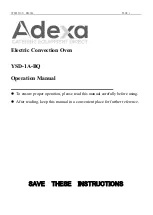
Cooking and heating up in the microwave oven
24
Size and shape of microwave-suitable containers
Flat, broad containers are better than narrow, tall ones. “Flat” foods can be cooked
more evenly.
Round or oval containers are more suitable than angular ones. There is a danger of
local overheating in the corners.
Materials that are partially suitable
• Stoneware and ceramics. Use clay containers only for defrosting and for short
cooking times because the air and water content of the material could cause the
clay to crack or break.
• Dishes with gold or silver trim should only be used if they have been labelled
“microwave-safe” by the manufacturer.
• Never use aluminium foil in large quantities. It can however be used e.g.
in small pieces to cover sensitive parts. You can also cover the corners of
containers to prevent overcooking as the microwave energy is primarily
concentrated on the corners. Maintain a distance of 2.5 cm between the foil and
the internal wall.
• Aluminium containers (e.g. those for ready-to-serve meals) are partially
suitable, but they must be at least 3 cm high to be used in the microwave oven.
Unsuitable materials
• Metal, i.e. metal pots, pans and lids.
WARNING!
Risk of fi re!
There is a risk of fi re due to improper use of the appliance.
− As soon as you notice sparks or fl ashes, switch off the
microwave immediately by pressing the
14
button twice.
Unplug the mains plug. Remove the food from the appliance
and check whether there are any metal objects in or on the
food or dish.
Summary of Contents for MD 18637
Page 1: ...DESIGN INSPIRED MICROWAVE User Manual ...
Page 3: ...3 A 1 2 3 4 5 8 9 6 7 Overview ...
Page 4: ...4 B C 10 12 11 13 14 Overview ...
Page 5: ...5 E D Use ...
Page 44: ...44 ...
















































